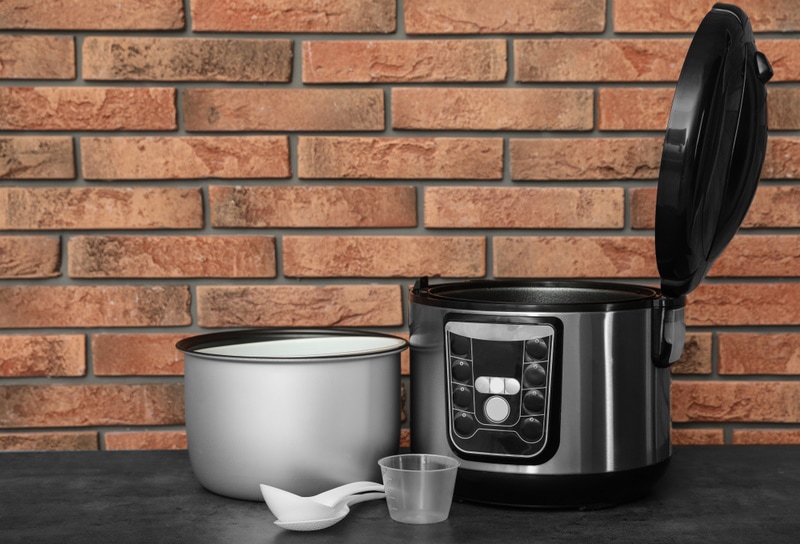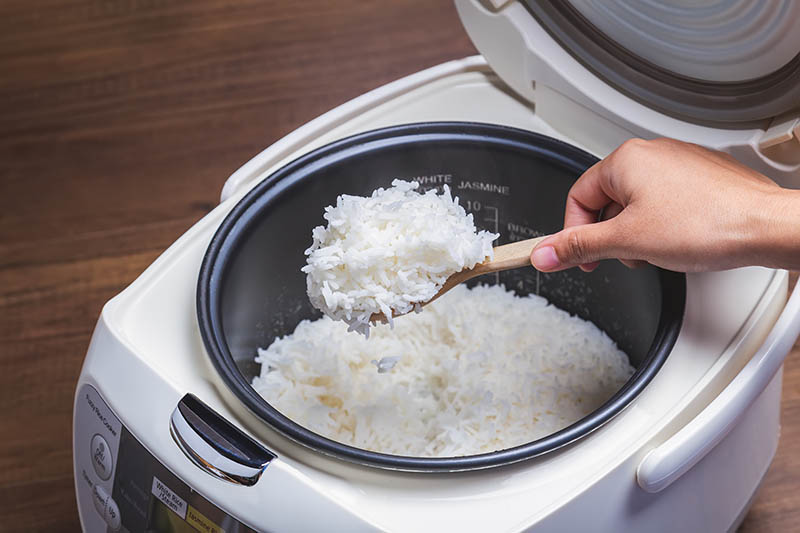How Does a Rice Cooker Work? The Interesting Answer!
-

- Last updated:

Rice is considered a staple in different cultures. In fact, according to history (and the statistical data collected) this is one of the few grains that have been cultivated for thousands of years, and still remains one of the most popular foods around the world.
In America, it’s been estimated that we consume more than 4 million metric tons1 of rice annually. Ironically, cooking it to perfection using stovetop cooking pots has always been a challenge.
Have they invented an appliance that resolves this problem? Yes, and it’s called a rice cooker. If you’d like to learn more about its inner workings, keep on reading.

How Does It Work?
To transform these little hard grains into fluffy ones, you’ll need two things—heat and water. And like most processes that involve those two elements, this particular one is also characterized by a series of stages.
In the first stage, you’ll have rice sitting in water. It will then be brought to a boil in the second stage, before being left to absorb water in the third stage. The final phase is the resting stage.
Components Of a Rice Cooker

- Spring-loaded thermometer
- Electric-heating plate
- Inner-cooking pan
- The main chassis
The “sitting stage” usually takes place inside the cooking pan, which is meant to go into the shell. If you’d like to measure the temperature of the contents beforehand, you can use the thermometer. Just set it at the bottom section of the main body and it will accurately record the readings.
While we have various types of rice cookers, the standard base model is often designed to heat up its contents by conveying heat energy from the heating plate to the pan. What’s more, the type of metal used in production can negatively or positively influence the heat transmission process. Copper, for example, is a highly conductive metal. And that would imply that if the rice cooker’s parts were made of copper, the overall time taken to prepare the dish would significantly reduce.
Cooking rice is not a complex process. The water temperature will keep rising until it gets to 100ºC, which is the equivalent of 212ºF.
The temperature in the pan will start rising once more after the rice has absorbed all the water in the pan. This subsequent rise will trigger a response from the cooker, compelling it to either change its setting to a warming cycle or to just switch off.
What Are the Different Types of Rice Cookers?
Fuzzy-Logic Cookers

These models usually rely on computer chips to make temperature and cooking time adjustments in real time. They are more electrical than mechanical and are programmed to operate in a more human-like fashion. Instead of working with strict data sets, they often depend on the fuzzy logic algorithm that’s meant to employ a more pragmatic approach in the decision-making processes.
This is a more practical way of looking at things, seeing as we aren’t relying on hard parameters. The approach uses numbers to include non-definitive phrases and words like “almost” or “to some degree” in its decision-making processes.
On a hot summer day, a conventional cooker will cook your rice a lot faster. The fuzzy-logic iteration, on the other hand, will quickly notice that the rice in the pan is heating up quicker than usual, and immediately reduce the heat.
Induction-Heating Cookers
These cookers are more advanced compared to the fuzzy-logic variants, as they are more precise in their operations. To achieve induction heating, you’ll have to pass current through an electrically conductive material such as steel, aluminum, or copper. The current will move through the material, which will be in the shape of a coil, creating a magnetic field that generates heat. It’s in that coil where you’ll find the cooking pan meant to hold the rice.
Some of these cookers have inner cooking pans that are made from magnetic materials as well. In such cases, heat is normally generated through hysteresis—a phenomenon where heat is automatically generated as a result of the friction created by a resistance to changes in the material’s magnetic level.
Induction-heating cookers are superior in that they have the ability to make minute-by-minute adjustments to temperature and cooking time. Their cooking pans are also surrounded by heat distribution conductors, to ensure the food is cooked evenly.
- The process is automated: We’ve never seen or heard anyone fussing over this appliance the way other people do while using a different cooking vessel. It doesn’t require any level of experience, as all you have to do is ensure you have the right ratio of rice and water. The cooker will automatically switch itself off when the cycle is complete.
- Makes sure the food stays warm: This will depend on the type of model you’re using. If you’re still using the old-generation model, chances are it doesn’t have the built-in warming feature.
- Easy to clean: Most rice cookers are dishwasher-safe, in case you were wondering. Their components are durable and offer a high level of resistance to water damage.
- Some models don’t automatically turn off: A good model should automatically turn off when the cooking cycle is complete, even if you’ve forgotten to unplug it. Some of them usually stay on, and that’s dangerous.
- Utilizes non-stick technology: This limits the number of utensils that can be used to scoop out the rice. If you keep on using metal utensils, the interior surface will be riddled with scratches, resulting in a substandard cooking experience.
- Easy for the bottom layer to burn: We’re often advised to always stir the rice every couple of minutes to save the bottom layer.

Conclusion
Most rice cookers are designed to prepare other dishes, besides rice. So, you can clearly see why we view them as a must-have appliance in every household. If you’re going to buy one, make sure it has all the important features. It needs to have a timer, an automatic shutdown function, a pressure cooker option, and a food-warming mode. That’s the only way to guarantee that you’re getting value for your money.
Featured Image Credit: Michael Dechev, Shutterstock
Contents
